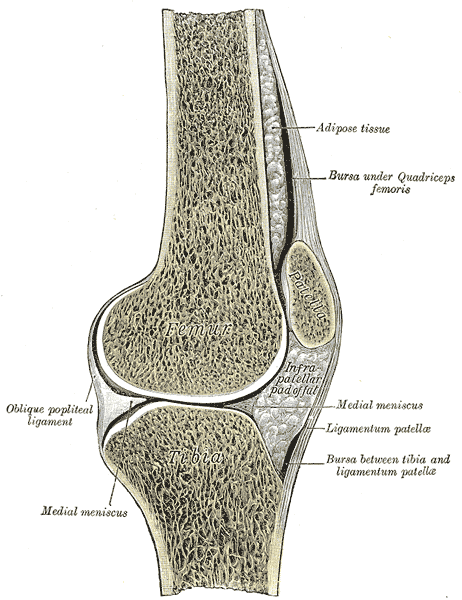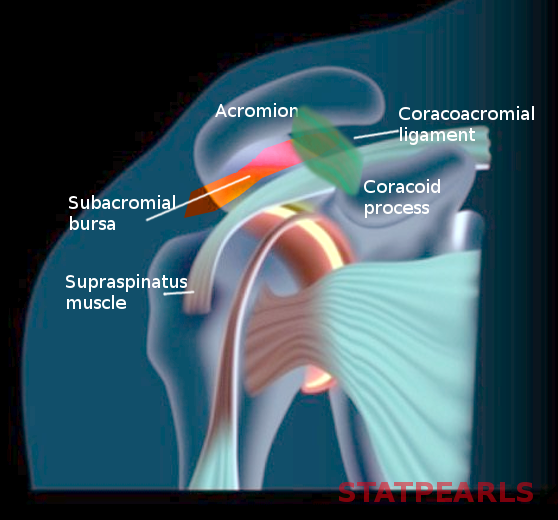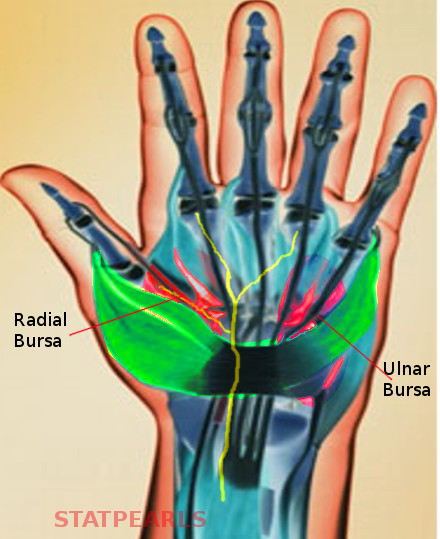Introduction
The largest organ of the human body is the skin. This organ comprises the epidermis, dermis, and hypodermis, which have additional layers categorized by the structures and characteristics of each layer. Below the skin lie muscles, ligaments, tendons, soft tissue, and bone. Bursa, and bursas or bursae for the plural form, is an important lubricated fluid-filled thin sac located between bone and surrounding soft tissue, bones and tendons, and/or muscles around joints, and are useful to the human body by reducing tension and negative effects of wear-and-tear at points of friction and provide resistance-free movement by the human body.[1] The bursa sac is lined by a synovial membrane or synovium, which contains the synovial fluid comparable to the consistency of raw egg whites. The sac is semi-permeable and allows certain materials to flow in and out of its membrane; when an injury to the bursa, fluid, such as blood, can fill the sac and irritate it. All 160 bursae that are present within the adult body vary in size and shape depending on the person and the location of the bursa; some bursae are not present at birth and develop as friction increases with age.[2] Bursae are classified as superficial when their structure lies between bones, tendons, or skin and deep when they’re between bones and muscles.[3] See Image. Hand Bursae.
Structure and Function
Register For Free And Read The Full Article
Search engine and full access to all medical articles
10 free questions in your specialty
Free CME/CE Activities
Free daily question in your email
Save favorite articles to your dashboard
Emails offering discounts
Learn more about a Subscription to StatPearls Point-of-Care
Structure and Function
Classifications of Bursae
Bursae are primarily synovial bursae that are constant in their location and predictable. They tend to form during embryonic development. The other, less common type is the adventitious bursa, which tends to form in response to repeated forces or friction originating within the body or from outside the skin.
Adventitious
The adventitious bursae exist in soft tissues to relieve repeated friction from natural movements or unusual and damaging pressure; this is the only non-native bursa. These bursae cover bony prominences throughout the body and are called accidental bursae. An example of an adventitious bursa that develops relative to hallux valgus on the inner big toe base is a bunion.[4] A major factor in the development of this bursa is wearing tightly fit shoes and improper foot care. Occasionally, a few subcutaneous bony deformities can be a causative factor. See Image. Extrinsic Foot Muscles. They are histologically characterized by mucoid and myxomatous degeneration of connective tissue and lack a true endothelial intima lining.
Synovial
Most bursae in the human body are synovial bursae, most common near large joints in the extremities, are located between tissues, and are defined as thin, synovial membrane sacs.[5] A capillary film of synovial fluid on the inner surface of the sac surfaces acts as a lubricant. Depending on their position, they classify as subcutaneous, subtendinous, submuscular, or subfascial bursae. They sometimes communicate with the joint cavity; their synovial membranes are continuous in such cases. Their lining is a cellular intima layer, which secretes the lubricating fluid.
Embryology
The skin develops from the ectoderm and mesoderm layers of the primitive embryo. The ectoderm contributes to the epidermis and some skin glands, while the connective tissue derives from the mesoderm layer.
Blood Supply and Lymphatics
The synovial bursae predominantly have good blood and lymphatic supply. When there is any trauma or infection, the cardinal signs of inflammation, namely redness, pain, and swelling of the sac and its surrounding skin, can present in superficial bursae on clinical examination. They can also produce signal changes in proper imaging like MRI and ultrasound scans.
Physiologic Variants
Location of Bursa
Subcutaneous
Subcutaneous bursae can be considered adventitious when they become abnormal and develop a distinct wall. They appear between the subcutaneous tissue and deep fasciae junction or bony prominences.
Submuscular
The submuscular bursae exist between adjacent muscles or muscles and bony prominences. Bursa naming is according to the location within the human body: bursae of the upper body include subacromial, subscapular, and olecranon; bursae of the hip include ischiogluteal, iliopsoas, and trochanteric; bursae of the knee include medial collateral ligament, pes anserinus, prepatellar, infrapatellar, popliteal bursa; and the ankle bursa is Retrocalcaneal. See Image. Sagittal Section of the Right Knee Joint.
Upper Body Bursae
The subacromial bursa lies between the acromion and the rotator cuff. This bursa protrudes laterally from below the acromion when the arm is at rest and moves medially below the bone when the person lifts their arm away from the center of the body. See Image. Subacromial Bursa. The subscapular bursa lies between the frontward-facing scapula surface and the backward-facing chest wall. There are 2 olecranon bursae, with the first bursa lying between the tricep tendons, the posterior elbow ligament, and the olecranon. In contrast, the second bursa lies more superficially between where the triceps attach to the olecranon and the skin.
Hip Bursae
The ischiogluteal bursa lies deep within the gluteus maximus and surfaces the ischial tuberosity. The iliopsoas bursa is the largest bursa in the human body, extending into the iliac fossa and lying between the lesser trochanter and the iliopsoas tendon. The trochanteric bursa extends superficially between the tensor fascia latae and the skin while also lying deeply between the tensor fasciae latae and the greater trochanter.
Knee Bursae
The medial collateral ligament bursa lies between the knee's superficial and deep medial collateral ligament. The pes anserinus bursa lies between the hamstring tendons and the superficial collateral ligament. The prepatellar bursa is anteriorly over the knee’s patella and below the skin. The infrapatellar bursa contains a superficial component as well as a deep component. The superficial bursa is between the patellar ligament and the skin, while the deep bursa is between the patellar ligament and the proximal aspect of the anterior tibia. The popliteal bursae are known as baker cysts and lie in the posterior joint capsule of the knee.
Ankle Bursae
The retrocalcaneal bursa is at the back of the heel and lies deep into the Achilles tendon and above the calcaneus bone. Occasionally, you can see a bursa over the medial malleolus, the subcutaneous medial bursa, and a bursa behind the heel called the subcutaneous calcaneal bursa.
Surgical Considerations
Inflamed Bursae
Irritation to any part of the body can cause inflammation. Any inflammation of the bursa is called bursitis. This inflammatory response can result from a minor, repetitive impact on the surrounding bursa area or can occur from sudden and more urgent injuries.[6] Other factors that affect bursitis formation include age, a body’s elasticity and ability to tolerate stress, and diseases such as rheumatoid arthritis, thyroid disease, or infection. Additionally, any overuse or impairment to the bursa or surrounding body parts- joint, bone, tendon, muscle, or ligament- can increase the risk of bursitis. Common symptoms of bursitis may include discomfort, tenderness, redness, swelling in the affected area, difficulty or loss of movement, and fever.[7]
Septic Bursitis and Surgical Considerations
Patients can also present with sudden onset of redness and pain in a previously inflamed bursa. That could result from infection, which can be due to poor host immune response or a direct inoculation with penetrating trauma or an insect bite.[8] When conservative measures to treat the painful and infected bursa have failed, surgical inversion may be required to drain the collection.[9]
In certain scenarios, the clinical findings might not be adequate to differentiate septic bursitis from friction, crystal deposition, or inflammatory conditions. The recommendation is aspiration under aseptic precautions and, if required, with ultrasound guidance, followed by oral antibiotics.[10] The Aspirate should have microbiology and biochemistry assessments. Antibiotics should be changed depending on the culture and sensitivity of the results. Surgical treatment for recurrent bursitis is not standardized with supporting evidence. There is a considerable variation in treatment modalities across the globe. The patient should be made aware of the potential risks associated with surgical excision, including infection, delayed healing, sinus formation, the persistence of pain, and recurrence.[10]
Clinical Significance
Bursitis can be treated through many interventions, including rest, stretching, and physical therapy. Non-steroidal anti-inflammatory drugs such as ibuprofen, aspirin, naproxen, COX-2 inhibitors, topical medications such as lidocaine patches, NSAIDs, or analgesics, aspiration to drain the excess fluid to relieve bursa pressure, corticosteroid injections, antibiotics, RICE: rest, ice, compression, elevation, and in some cases- surgery.[11] The required treatment for bursitis depends on the inflamed sac's location, the inflammatory response's severity, and the condition's duration.
Sub-acromial bursitis is a common diagnosis in patients presenting with shoulder pain, particularly in young and active populations. Often, their symptoms are exaggerated with overhead activities. A thorough clinical examination supported by appropriate imaging is vital in confirming the diagnosis and developing a treatment plan. Most patients notice improvement with activity modifications, rest, analgesics, and appropriate physiotherapy. Referral to specialists for surgical intervention is recommended when these modalities fail.
Clinicians can adequately manage trochanteric bursitis with anti-inflammatory medications, rest, and physiotherapy. Ultrasound-guided steroid injections are proven to provide good relief in a few patients, while there is increasing evidence for injecting platelet-rich plasma.[7][12][13] Additionally, steroid injections require precise pre-procedural evaluation, technique, and post-procedural guidance. The research completed on these injections proves the effectiveness of the current methods to treat pathological bursae in most anatomic locations.[14] During the pre-procedural evaluation, the patients are advised to complete relevant lab work and imaging while discussing allergies, medical history, current medications and signing consents.[14] Once the patient is cleared by the physician for the ultrasound-guided bursal injections, the physician examines the bursa and decides the most appropriate medical items and equipment to use. A 22-gauge or 25-gauge needle is often used to aspirate the fluid from the infected bursa.[14] A thicker gauge needle may be recommended and used if the fluid is viscous.
The steroids used during ultrasound-guided injections have different concentrations and properties, so it is important to know which ones to use in different anatomical locations. The common steroids used include methylprednisone, betamethasone, or triamcinolone.[14] Research proves that these steroids have lower solubility than a steroid such as dexamethasone.[14] The appropriate steroid solution lasts longer at the injection site compared to non-particulate steroids.[14] To confirm the correct anatomical location, a small amount of lidocaine may be injected into the surrounding areas of the bursa before the steroid injection.[14] This technique can be helpful to identify bursae that are difficult to locate without distention. Before administering any medication, the providers should assess and document evidence of allergy reactions. If the patient has a documented allergy to lidocaine or other similar anesthetics, then the provider should use an anesthetic such as chloroprocaine.[14] Although ultrasound-guided bursal injections are difficult to execute, these procedures establish more accurate results than injections into bursae by palpating certain body sites.[14] The post-procedural instructions include keeping the area dry for 24 hours, completing a functional assessment and pain assessment, and being informed that the full relieving effects from the steroid injection may take up to 7 days.[14]
Media
(Click Image to Enlarge)

Sagittal Section of the Right Knee Joint. Oblique popliteal ligament, medial meniscus, infrapatellar pad of fat, ligamentum patella, bursa between tibia and ligamentum patella, and bursa under quadriceps femoris.
Henry Vandyke Carter, Public Domain, via Wikimedia Commons
(Click Image to Enlarge)

Extrinsic Foot Muscles. This medial view of the right foot shows the tendons of the tibialis anterior, tibialis posterior, flexor digitorum longus, extensor hallucis longus, and flexor hallucis longus. The retrocalcaneal bursa, tendo calcaneus (Achilles tendon), and transcrural and cruciate ligaments are also shown.
Henry Vandyke Carter, Public Domain, via Wikimedia Commons
(Click Image to Enlarge)
References
De Oliveira-Lagôa S, Cruz FB, Azócar DLM, Lavilla EO, Abdala V. Anuran forelimb muscle tendinous structures and their relationship with locomotor modes and habitat use. Current zoology. 2019 Oct:65(5):599-608. doi: 10.1093/cz/zoy086. Epub 2018 Nov 30 [PubMed PMID: 31616491]
Omidi S, Ebrahimi M, Janmohammadi H, Moghaddam G, Rajabi Z, Hosseintabar-Ghasemabad B. The impact of in ovo injection of l-arginine on hatchability, immune system and caecum microflora of broiler chickens. Journal of animal physiology and animal nutrition. 2020 Jan:104(1):178-185. doi: 10.1111/jpn.13222. Epub 2019 Oct 6 [PubMed PMID: 31587369]
Level 3 (low-level) evidenceSawyer E, Black AC, Launico MV, Varacallo M. Anatomy, Shoulder and Upper Limb, Hand Ulnar Bursa. StatPearls. 2024 Jan:(): [PubMed PMID: 31082069]
Holme TJ,Sivaloganathan SS,Patel B,Kunasingam K, Third-Generation Minimally Invasive Chevron Akin Osteotomy for Hallux Valgus. Foot [PubMed PMID: 31522534]
Gursoy M, Mete BD, Dag F, Bulut T. The distribution of loose bodies determined on knee magnetic resonance imaging: joint compartments, recesses and bursae including arthroscopic blind spots. Acta radiologica (Stockholm, Sweden : 1987). 2019 Oct:60(10):1286-1293. doi: 10.1177/0284185119856262. Epub 2019 Jun 19 [PubMed PMID: 31216177]
Held MFG, Laubscher M, Graham SM, Kruger N, Njisane P, Njisane V, Dunn RN, Learning Innovation via Orthopaedic Networks (LION) Group. Topics, Skills, and Cases for an Undergraduate Musculoskeletal Curriculum in Southern Africa: A Consensus from Local and International Experts. The Journal of bone and joint surgery. American volume. 2020 Feb 5:102(3):e10. doi: 10.2106/JBJS.19.00664. Epub [PubMed PMID: 31596812]
Level 3 (low-level) evidenceSeidman AJ, Taqi M, Varacallo M. Trochanteric Bursitis (Archive). StatPearls. 2024 Jan:(): [PubMed PMID: 30860738]
Herring K,Mathern S,Khodaee M, Septic Infrapatellar Bursitis in an Immunocompromised Female. Case reports in orthopedics. 2018 [PubMed PMID: 29984025]
Level 3 (low-level) evidenceKaiser P, Schmidle G, Raas C, Blauth M. [Treatment concept for a traumatic lesion of the prepatellar bursa]. Operative Orthopadie und Traumatologie. 2015 Oct:27(5):427-36; 437-8. doi: 10.1007/s00064-015-0414-8. Epub 2015 Aug 28 [PubMed PMID: 26314411]
Meade TC, Briones MS, Fosnaugh AW, Daily JM. Surgical Outcomes in Endoscopic Versus Open Bursectomy of the Septic Prepatellar or Olecranon Bursa. Orthopedics. 2019 Jul 1:42(4):e381-e384. doi: 10.3928/01477447-20190321-04. Epub 2019 Mar 27 [PubMed PMID: 30913297]
Franco Palacios CR, Thompson AM, Gorostiaga F. A past medical history of heart failure is associated with less fluid therapy in septic patients. Revista Brasileira de terapia intensiva. 2019:31(3):340-346. doi: 10.5935/0103-507X.20190049. Epub 2019 Oct 14 [PubMed PMID: 31618353]
Oderuth E, Ali M, Atchia I, Malviya A. A double blind randomised control trial investigating the efficacy of platelet rich plasma versus placebo for the treatment of greater trochanteric pain syndrome (the HIPPO trial): a protocol for a randomised clinical trial. Trials. 2018 Sep 21:19(1):517. doi: 10.1186/s13063-018-2907-x. Epub 2018 Sep 21 [PubMed PMID: 30241561]
Level 1 (high-level) evidenceAli M, Oderuth E, Atchia I, Malviya A. The use of platelet-rich plasma in the treatment of greater trochanteric pain syndrome: a systematic literature review. Journal of hip preservation surgery. 2018 Aug:5(3):209-219. doi: 10.1093/jhps/hny027. Epub 2018 Aug 30 [PubMed PMID: 30393547]
Level 1 (high-level) evidenceMcGill KC, Patel R, Chen D, Okwelogu N. Ultrasound-guided bursal injections. Skeletal radiology. 2023 May:52(5):967-978. doi: 10.1007/s00256-022-04153-y. Epub 2022 Aug 26 [PubMed PMID: 36008730]

